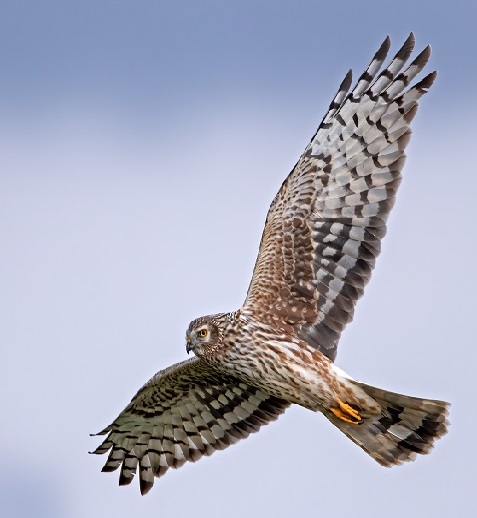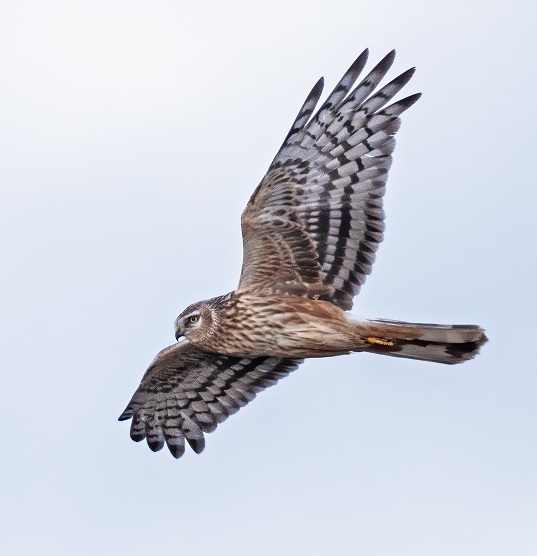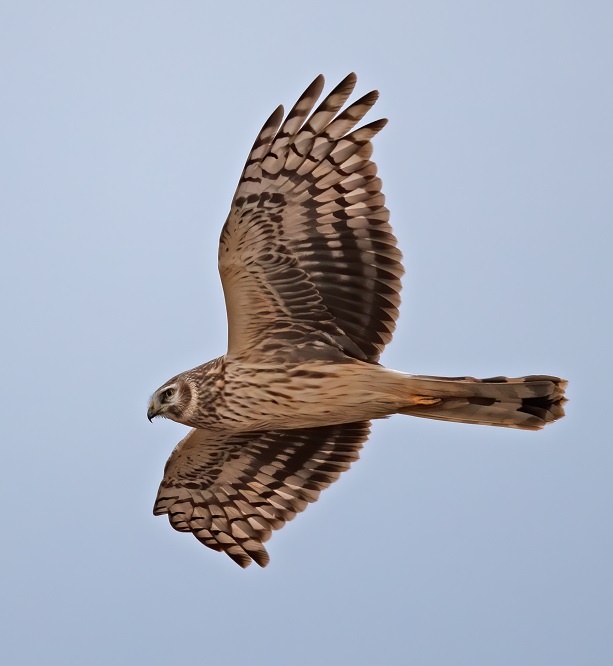How to accurately determine the age and sex of “brown” hen harriers remained a mystery for a long time, despite the authors Clark and Forsman laying the groundwork some time ago. Nevertheless, this was unable to prevent contradictory information being included in various field guides (including the images presented therein), which often did not correspond with reality.
The silhouette of adult female hen harriers, which are relatively abundant this winter due to their low breeding success, is easily recognizable due to the birds’ strong physique with broad, rounded wings. In addition, they possess a distinctive broad black terminal band across the tips of their wings that grows wider towards the body and is very clearly separated by a narrow light band preceding it (Fig. 1).
This distinguishes them from the otherwise quite similar looking juvenile males, which have narrower and more pointed wings and in which the light band across the forearm narrows less towards the body, thus creating an almost identical impression (Fig. 2).
Because of the low facial contrast typical for both adult females and young males, they were occasionally confused in the literature in the past. In addition, the rounded features of the face are common to both older females and young males. In this case, the only thing that helps is a good look at the lighter neck area, because in older females it is less pronounced, usually indistinguishable, and narrow, while in young males it remains predominantly broad and clearly visible. Older females usually also lack the clearly visible spotting on the neck typical of many birds of prey, which can be recognized in nearly all fledglings, female and male alike.
Young females (Fig. 3) can be clearly distinguished from adult females and young males by their more angular and contrasting facial pattern. Characteristic here is the dark area where the brown malar region connects to the beak, which is referred to as the “moustache stripe” and is almost always pronounced. The transition from the light eye ring to the dark malar region is relatively stark and therefore exhibits a more marked contrast than in old females and young males. On the other hand, the coloration of the underside of young females reveals less of a contrast than in older females and young males. Less distinct light bands run across the underside of the arms, which are usually narrower and darker towards the body. These bands may thin to such an extent that they are only partially or not at all recognizable. The abdomen of young females is relatively uniformly colored and patterned. The dark striation becomes continuously thinner and sparser from the breast to the undertail coverts. Young males and particularly adult females exhibit a more varied underside and frequently possess more “colorful” bands and occasionally spots. Contrary to common belief, the use of eye color as an identifying feature should be viewed critically, as both juvenile and adult females may have a yellow iris, but this is also the norm in juvenile males from the first fall.
Although many characteristics exhibit a more or less strong overlap, their combination makes it possible to correctly determine the age and sex of birds in more than 99 percent of all cases, particularly if several characteristics can be identified due to favorable observation conditions and the use of high-quality optics.
Nevertheless, determining the age and sex of female hen harriers is by no means an easy ornithological task and is therefore difficult for beginners. But even advanced ornithologists only succeed in identifying them after some practice and with the resulting experience. This skill can be acquired, however, by reading a more technical article that describes additional characteristics and contains images of 57 different hen harriers, which can be downloaded from the following website:


